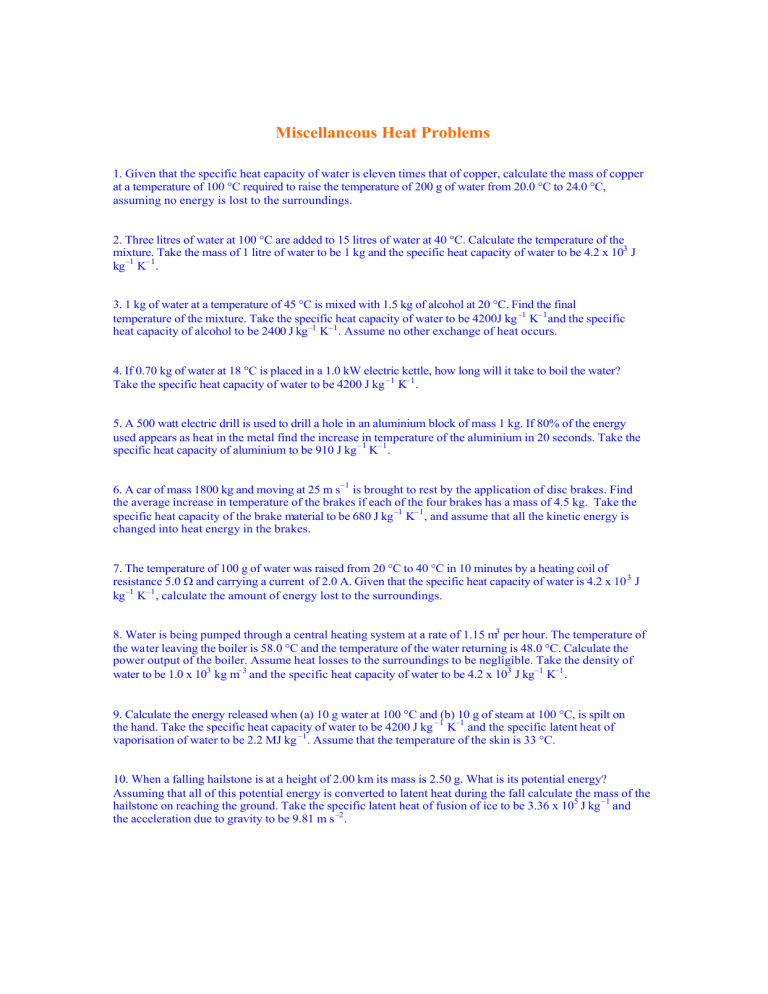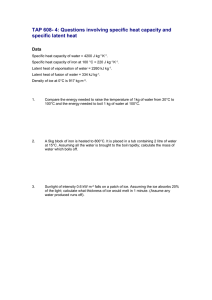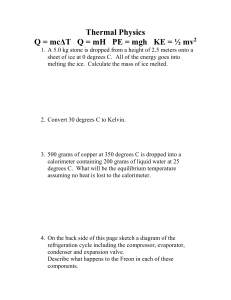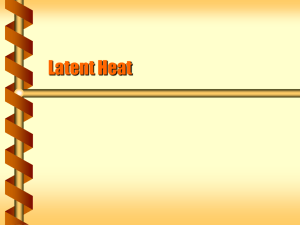
Miscellaneous Heat Problems 1. Given that the specific heat capacity of water is eleven times that of copper, calculate the mass of copper at a temperature of 100 °C required to raise the temperature of 200 g of water from 20.0 °C to 24.0 °C, assuming no energy is lost to the surroundings. 2. Three litres of water at 100 °C are added to 15 litres of water at 40 °C. Calculate the temperature of the mixture. Take the mass of 1 litre of water to be 1 kg and the specific heat capacity of water to be 4.2 x 103 J kg –1 K–1 . 3. 1 kg of water at a temperature of 45 °C is mixed with 1.5 kg of alcohol at 20 °C. Find the final temperature of the mixture. Take the specific heat capacity of water to be 4200J kg –1 K–1 and the specific heat capacity of alcohol to be 2400 J kg–1 K–1 . Assume no other exchange of heat occurs. 4. If 0.70 kg of water at 18 °C is placed in a 1.0 kW electric kettle, how long will it take to boil the water? Take the specific heat capacity of water to be 4200 J kg –1 K–1 . 5. A 500 watt electric drill is used to drill a hole in an aluminium block of mass 1 kg. If 80% of the energy used appears as heat in the metal find the increase in temperature of the aluminium in 20 seconds. Take the specific heat capacity of aluminium to be 910 J kg –1 K–1 . 6. A car of mass 1800 kg and moving at 25 m s–1 is brought to rest by the application of disc brakes. Find the average increase in temperature of the brakes if each of the four brakes has a mass of 4.5 kg. Take the specific heat capacity of the brake material to be 680 J kg –1 K–1 , and assume that all the kinetic energy is changed into heat energy in the brakes. 7. The temperature of 100 g of water was raised from 20 °C to 40 °C in 10 minutes by a heating coil of resistance 5.0 Ω and carrying a current of 2.0 A. Given that the specific heat capacity of water is 4.2 x 10 3 J kg –1 K–1 , calculate the amount of energy lost to the surroundings. 8. Water is being pumped through a central heating system at a rate of 1.15 m3 per hour. The temperature of the water leaving the boiler is 58.0 °C and the temperature of the water returning is 48.0 °C. Calculate the power output of the boiler. Assume heat losses to the surroundings to be negligible. Take the density of water to be 1.0 x 103 kg m–3 and the specific heat capacity of water to be 4.2 x 103 J kg–1 K–1 . 9. Calculate the energy released when (a) 10 g water at 100 °C and (b) 10 g of steam at 100 °C, is spilt on the hand. Take the specific heat capacity of water to be 4200 J kg –1 K–1 and the specific latent heat of vaporisation of water to be 2.2 MJ kg –1 . Assume that the temperature of the skin is 33 °C. 10. When a falling hailstone is at a height of 2.00 km its mass is 2.50 g. What is its potential energy? Assuming that all of this potential energy is converted to latent heat during the fall calculate the mass of the hailstone on reaching the ground. Take the specific latent heat of fusion of ice to be 3.36 x 105 J kg –1 and the acceleration due to gravity to be 9.81 m s –2 . 11. 0.30 kg of ice at 0 °C is added to 1.0 kg of water at 45 °C. What is the final temperature, assuming no heat exchange with the surroundings? Take the specific heat capacity of water to be 4200 J kg–1 K–1, and the specific latent heat of fusion of ice to be 3.4 x 105 J kg –1 K–1 12. A copper calorimeter of mass 180 g contains 450 g of water and 50 g of ice, all at 0 °C. Dry steam is passed into the calorimeter until a certain temperature, θ, is reached. The mass of the calorimeter and its contents at the end of the experiment increased by 25 g. If no heat was lost to the surroundings find the final temperature, θ. Take the specific heat capacities of water and copper to be 4200 J kg–1 K–1 and 390 J kg –1 K–1 , respectively. Take the specific latent heat of fusion of ice to be 3.36 x 105 J kg –1 and the specific latent heat of vaporisation of water to be 2.26 x 106 J kg–1 . 13. A refrigerator converts 1.3 kg of water at 20 °C into ice at -15 °C in 1 hour. Calculate the total heat removed and the effective power of the refrigerator. Take the specific latent heat of ice to be 3.4 x 105 J kg -1, the specific heat capacity of water to be 4.2 x 103 J kg–1 K–1 and the specific heat capacity of ice to be 2.1 x 103 J kg–1 K–1 . 14. Given that the specific heat capacity of air is 1.0 x 103 J kg–1 K–1 calculate how much energy must be removed from a refrigerator containing 0.15 m3 of air to lower the temperature of the air from 20 °C to 4 °C (take density of air = 1.2 kg m–3 ). 1. Given that the specific heat capacity of water is eleven times that of copper, calculate the mass of copper at a temperature of 100 °C required to raise the temperature of 200 g of water from 20.0 °C to 24.0 °C, assuming no energy is lost to the surroundings. Heat lost by copper (mc∆θ)cu mcuccu(100 - 24) 76mcu mcu = = = = = heat gained by water (mc∆θ)w 0.200 x 11c cu(24 – 20) 8.8 0.116kg Note: The quantities given in the question have only three significant figures; this restricts the answer to an accuracy of about 1%. 2. Three litres of water at 100 °C are added to 15 litres of water at 40 °C. Calculate the temperature of the mixture. Take the mass of 1 litre of water to be 1 kg and the specific heat capacity of water to be 4.2 x 103 J kg –1 K–1 . Let the temperature of the mixture θ Heat lost (mc∆θ)1 3 x 4.2 x 10 3 x (100 - θ) Solving for θ gives θ = 50 o C = = = heat gained (mc∆θ)2 15 x 4.2 x 103 x (θ - 40) 3. 1 kg of water at a temperature of 45 °C is mixed with 1.5 kg of alcohol at 20 °C. Find the final temperature of the mixture. Take the specific heat capacity of water to be 4200J kg –1 K–1 and the specific heat capacity of alcohol to be 2400 J kg –1 K–1 . Assume no other exchange of heat occurs. Let the final temperature of the mixture be θ Heat lost by water (mc∆θ)w 1 x 4200 x (45 - θ) = = = heat gained by alcohol (mc∆θ)al 1.5 x 2400 x (θ - 20) Solving for θ gives θ = 33 o C 4. If 0.70 kg of water at 18 °C is placed in a 1.0 kW electric kettle, how long will it take to boil the water? Take the specific heat capacity of water to be 4200 J kg –1 K–1 . Heat gained by the water = mc∆θ = 0.7 x 4200 x 82 = 2.4108 x 105 J 3 –1 Power = 1 kW = 10 J s = electrical energy supplied/time taken Time taken = 2.4108 x 105 / 103 = 241 seconds or 4 minutes Note: In practice, the actual time would exceed the 4 minutes, as some energy goes to heat the material of the kettle, and some is lost to the surroundings. 5. A 500 watt electric drill is used to drill a hole in an aluminium block of mass 1 kg. If 80% of the energy used appears as heat in the metal find the increase in temperature of the aluminium in 20 seconds. Take the specific heat capacity of aluminium to be 910 J kg –1 K–1 . 500 watt = 500 joule per second Energy used in 20 s = 500 x 20 = 10 000 J 80% of this is converted to heat in the aluminium block So, 0.80 x 10 000 = 8000 J converted to heat in block Now, 8000 = mc∆θ = 1 x 910 x ∆θ So, ∆θ = 8.8 K 6. A car of mass 1800 kg and moving at 25 m s–1 is brought to rest by the application of disc brakes. Find the average increase in temperature of the brakes if each of the four brakes has a mass of 4.5 kg. Take the specific heat capacity of the brake material to be 680 J kg –1 K–1 , and assume that all the kinetic energy is changed into heat energy in the brakes. Kinetic energy = ½ mv2 = 0.5 x 1800 x 625 = 5.625 x 105 J Four brakes, each of mass 4.5 kg gives a total mass of 18 kg. Heat gained by brakes = mc ∆θ = 18 x 680 x ∆θ Assuming all the kinetic energy is converted to heat energy 18 x 680 x ∆θ = 5.625 x 105 = 46 K ∆θ 7. The temperature of 100 g of water was raised from 20 °C to 40 °C in 10 minutes by a heating coil of resistance 5.0 Ω and carrying a current of 2.0 A. Given that the specific heat capacity of water is 4.2 x 103 J kg –1 K–1 , calculate the amount of energy lost to the surroundings. Energy supplied = I2 Rt = 22 x 5 x 600 = 12 x 103 J Energy used = mc∆θ = 0.1 x 4.2 x 103 x 20 = 8.4 x 103 J Energy lost to surroundings = 12 x 103 – 8.4 x 103 = 3.6 x 103 J 8. Water is being pumped through a central heating system at a rate of 1.15 m3 per hour. The temperature of the water leaving the boiler is 58.0 °C and the temperature of the water returning is 48.0 °C. Calculate the power output of the boiler. Assume heat losses to the surroundings to be negligible. Take the density of water to be 1.0 x 103 kg m–3 and the specific heat capacity of water to be 4.2 x 103 J kg–1 K–1 . Change in temperature of water = 58 – 48 = 10 K Heat lost = mc∆θ Density = mass / volume ⇒ Mass = density x volume So, Heat lost per hour = 1 x 103 x 1.15 x 4.2 x 103 x 10 = 4.83 x 107 joule per hour Now, Power = energy supplied / time = 4.83 x 107 / 3.6 x 103 = 13.4 kW 9. Calculate the energy released when (a) 10 g water at 100 °C and (b) 10 g of steam at 100 °C, is spilt on the hand. Take the specific heat capacity of water to be 4200 J kg –1 K–1 and the specific latent heat of vaporisation of water to be 2.2 MJ kg –1 . Assume that the temperature of the skin is 33 °C. (a) E = mc∆θ = 0.01 x 4200 x (100 – 33) = 2814 J = 2.8 kJ (b) The latent heat given out in changing from steam at 100 °C to water at the same temperature is E = ml = 0.01 x 2.2 x 106 = 22 000 J The heat given out when this condensed water drops in temperature from 100 °C to 33 °C is E = mcθ = 0.01 x 4200 x (100 – 33) = 2814 J So, the total heat given out is = 25 kJ 10. When a falling hailstone is at a height of 2.00 km its mass is 2.50 g. What is its potential energy? Assuming that all of this potential energy is converted to latent heat during the fall calculate the mass of the hailstone on reaching the ground. Take the specific latent heat of fusion of ice to be 3.36 x 105 J kg –1 and the acceleration due to gravity to be 9.81 m s –2 . Potential energy = mgh = 2.5 x 10–3 x 9.81 x 2 x 103 = 49.05 J The falling hailstone loses potential energy, and this is used to partly melt the hailstone. ml = 49.05 m x 3.36 x 105 = 49.05 m = 1.4598 x 10–4 kg (mass of hailstone that melted) Total mass of hailstone = 2.50 g => Remaining mass that reaches the ground = 2.50 – 0.1458 g = 2.354 g = 2.35 x 10–3 kg 11. 0.30 kg of ice at 0 °C is added to 1.0 kg of water at 45 °C. What is the final temperature, assuming no heat exchange with the surroundings? Take the specific heat capacity of water to be 4200 J kg–1 K–1, and the specific latent heat of fusion of ice to be 3.4 x 105 J kg –1 . Let θ be the final temperature. Heat lost by water = heat gained in melting the ice + heat gained in warming the ice water to a temperature (mc∆θ) w = mi l + mi c∆θi mw c(45 - θ) = mi l + mic∆θi 1 x 4200 x (45 - θ) = (0.3 x 3.4 x 105 ) + (0.3 x 4200 x θ) 4200 (45 – θ) = 1.02 x 105 + 1260 θ 1.89 x 105 – 1.02 x 105 = 1260 θ + 4200 θ θ = 16 0 C 12. A copper calorimeter of mass 180 g contains 450 g of water and 50 g of ice, all at 0 °C. Dry steam is passed into the calorimeter until a certain temperature, θ, is reached. The mass of the calorimeter and its contents at the end of the experiment increased by 25 g. If no heat was lost to the surroundings find the final temperature, θ. Take the specific heat capacities of water and copper to be 4200 J kg–1 K–1 and 390 J kg –1 K–1 , respectively. Take the specific latent heat of fusion of ice to be 3.36 x 105 J kg –1 and the specific latent heat of vaporisation of water to be 2.26 x 106 J kg–1 . Energy released when steam condenses at 100 °C is E = ml = 0.025 x 2.26 x 106 = 5.65 x 104 J Energy released when condensed steam cools from 100 °C to temperature θ is E = mc∆θ = 0.025 x 4200 x (100 – θ) = 1.05 x 104 – 105 θ Energy absorbed by 50 g of ice on melting at 0 °C is E = ml = 0.05 x 3.36 x 105 = 1.68 x 104 J Energy absorbed by 500 g of water (the original 450 g of water and 50 g of melted ice) in warming from 0 °C to θ is E = 0.5 x 4200 x θ = 2100 θ Energy absorbed by 180 g of copper (the calorimeter) in warming from 0 °C to θ is E = mc∆θ = 0.18 x 390 x θ = 70.2 θ Heat lost (a) + (b) 5.65 x 104 + 1.05 x 104 – 105 θ 5.02 x 104 θ (a) (b) (c) (d) (e) = heat gained = (c) + (d) + (e) = 1.68 x 104 + 2100 θ + 70.2 θ = 2.275 x 103 θ = 22 °C 13. A refrigerator converts 1.3 kg of water at 20 °C into ice at -15 °C in 1 hour. Calculate the total heat removed and the effective power of the refrigerator. Take the specific latent heat of ice to be 3.4 x 105 J kg -1, the specific heat capacity of water to be 4.2 x 103 J kg–1 K–1 and the specific heat capacity of ice to be 2.1 x 103 J kg–1 K–1 . Energy removed in cooling 1.3 kg water from 20 °C to 0 °C is E = mc∆θ = 1.3 x 4.2 x 103 x 20 = 1.092 x 105 J Energy removed in changing 1.3 kg of water at 0 °C to ice at 0 °C is E = ml = 1.3 x 3.4 x 105 = 4.42 x 105 J Energy remo ved in cooling 1.3 kg ice from 0 °C to –15 °C is E = mc∆θ = 1.3 x 2.1 x 103 x 15 = 4.095 x 104 J Total heat removed is E = 1.092 x 105 + 4.42 x 105 + 4.095 x 104 = 5.922 x 105 J Power = energy in joules / time in seconds = 5.922 x 105 / (60 x 60) = 164.5 W = 0.16 kW 14. Given that the specific heat capacity of air is 1.0 x 103 J kg–1 K–1 calculate how much energy must be removed from a refrigerator containing 0.15 m3 of air to lower the temperature of the air from 20 °C to 4 °C (take density of air = 1.2 kg m–3 ). Mass E = density x volume = 1.2 x 0.15 = 0.18 kg of air = mc∆θ = 0.18 x 103 x (20 – 4) = 2880 J = 2.9 kJ



